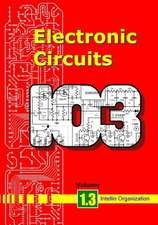Linear and Nonlinear Circuits: Basic and Advanced Concepts: Volume 2: Lecture Notes in Electrical Engineering, cartea 620
Autor Mauro Parodi, Marco Storaceen Limba Engleză Paperback – 30 ian 2021
This second volume focuses on dynamical circuits, which are characterized by time evolution and by the concept of state. The content is divided into a set of introductory and a set of advanced‐level topics, mirroring the approach used in the previously published volume. Whenever possible, circuits are compared to physical systems of different natures (e.g. mechanical or biological) that exhibit the same dynamical behavior. The book also features a wealth of examples and numerous solved problems. Further topics, such as a more general framing of linear and nonlinear components, will be discussed in volume 3.
| Toate formatele și edițiile | Preț | Express |
|---|---|---|
| Paperback (2) | 489.39 lei 6-8 săpt. | |
| Springer International Publishing – 2 aug 2018 | 489.39 lei 6-8 săpt. | |
| Springer International Publishing – 30 ian 2021 | 595.39 lei 6-8 săpt. | |
| Hardback (2) | 590.16 lei 6-8 săpt. | +36.81 lei 4-10 zile |
| Springer International Publishing – 30 ian 2020 | 699.31 lei 3-5 săpt. | +36.81 lei 4-10 zile |
| Springer International Publishing – 5 iul 2017 | 590.16 lei 6-8 săpt. |
Din seria Lecture Notes in Electrical Engineering
- 18%
 Preț: 1859.04 lei
Preț: 1859.04 lei - 18%
 Preț: 895.27 lei
Preț: 895.27 lei - 17%
 Preț: 397.66 lei
Preț: 397.66 lei - 18%
 Preț: 1562.17 lei
Preț: 1562.17 lei - 20%
 Preț: 1473.39 lei
Preț: 1473.39 lei - 18%
 Preț: 5169.60 lei
Preț: 5169.60 lei - 20%
 Preț: 1741.49 lei
Preț: 1741.49 lei - 20%
 Preț: 1918.04 lei
Preț: 1918.04 lei - 18%
 Preț: 1573.20 lei
Preț: 1573.20 lei - 18%
 Preț: 1851.77 lei
Preț: 1851.77 lei - 18%
 Preț: 1578.72 lei
Preț: 1578.72 lei - 18%
 Preț: 1903.08 lei
Preț: 1903.08 lei - 18%
 Preț: 2113.02 lei
Preț: 2113.02 lei - 18%
 Preț: 892.42 lei
Preț: 892.42 lei - 18%
 Preț: 1404.30 lei
Preț: 1404.30 lei - 18%
 Preț: 1133.61 lei
Preț: 1133.61 lei - 18%
 Preț: 1847.84 lei
Preț: 1847.84 lei - 18%
 Preț: 1384.56 lei
Preț: 1384.56 lei - 20%
 Preț: 1300.14 lei
Preț: 1300.14 lei - 20%
 Preț: 1174.76 lei
Preț: 1174.76 lei - 20%
 Preț: 1310.03 lei
Preț: 1310.03 lei - 18%
 Preț: 2546.29 lei
Preț: 2546.29 lei - 20%
 Preț: 1310.03 lei
Preț: 1310.03 lei - 18%
 Preț: 1676.58 lei
Preț: 1676.58 lei - 20%
 Preț: 1182.20 lei
Preț: 1182.20 lei - 18%
 Preț: 1392.46 lei
Preț: 1392.46 lei - 18%
 Preț: 1119.38 lei
Preț: 1119.38 lei - 18%
 Preț: 1678.16 lei
Preț: 1678.16 lei - 18%
 Preț: 1596.85 lei
Preț: 1596.85 lei - 18%
 Preț: 1398.00 lei
Preț: 1398.00 lei - 20%
 Preț: 1445.35 lei
Preț: 1445.35 lei - 18%
 Preț: 1244.89 lei
Preț: 1244.89 lei - 20%
 Preț: 1173.10 lei
Preț: 1173.10 lei - 18%
 Preț: 810.81 lei
Preț: 810.81 lei - 20%
 Preț: 1173.93 lei
Preț: 1173.93 lei - 20%
 Preț: 1482.47 lei
Preț: 1482.47 lei - 20%
 Preț: 1915.57 lei
Preț: 1915.57 lei - 18%
 Preț: 1387.73 lei
Preț: 1387.73 lei - 18%
 Preț: 1425.62 lei
Preț: 1425.62 lei - 20%
 Preț: 1297.67 lei
Preț: 1297.67 lei - 18%
 Preț: 1407.46 lei
Preț: 1407.46 lei - 18%
 Preț: 1667.91 lei
Preț: 1667.91 lei - 18%
 Preț: 1400.35 lei
Preț: 1400.35 lei - 18%
 Preț: 1117.03 lei
Preț: 1117.03 lei - 18%
 Preț: 1573.20 lei
Preț: 1573.20 lei - 18%
 Preț: 1405.90 lei
Preț: 1405.90 lei - 18%
 Preț: 726.37 lei
Preț: 726.37 lei - 18%
 Preț: 1405.90 lei
Preț: 1405.90 lei - 18%
 Preț: 1238.56 lei
Preț: 1238.56 lei - 18%
 Preț: 725.61 lei
Preț: 725.61 lei
Preț: 595.39 lei
Preț vechi: 700.46 lei
-15% Nou
Puncte Express: 893
Preț estimativ în valută:
113.92€ • 118.96$ • 94.08£
113.92€ • 118.96$ • 94.08£
Carte tipărită la comandă
Livrare economică 15-29 aprilie
Preluare comenzi: 021 569.72.76
Specificații
ISBN-13: 9783030350468
ISBN-10: 3030350460
Pagini: 515
Ilustrații: XV, 515 p. 455 illus., 31 illus. in color.
Dimensiuni: 155 x 235 mm
Greutate: 0.74 kg
Ediția:1st ed. 2020
Editura: Springer International Publishing
Colecția Springer
Seria Lecture Notes in Electrical Engineering
Locul publicării:Cham, Switzerland
ISBN-10: 3030350460
Pagini: 515
Ilustrații: XV, 515 p. 455 illus., 31 illus. in color.
Dimensiuni: 155 x 235 mm
Greutate: 0.74 kg
Ediția:1st ed. 2020
Editura: Springer International Publishing
Colecția Springer
Seria Lecture Notes in Electrical Engineering
Locul publicării:Cham, Switzerland
Cuprins
Basic concepts: two-terminal linear elements with memory and first-order linear circuits.- Advanced concepts: first-order nonlinear circuits.- Basic concepts: linear two-ports with memory and higher-order linear circuits.- Advanced concepts: Higher-order nonlinear circuits – State equations and equilibrium points.- Basic concepts: Analysis of LTI circuits in sinusoidal steady state.- Advanced concepts: Analysis of nonlinear oscillators.
Recenzii
“This is volume 2 of a basic book on linear and nonlinear circuits for undergraduate electrical engineering students.” (Wai-Kai Chen, zbMATH 1492.94002, 2022)
Notă biografică
Mauro Parodi was appointed full professor of Basic Circuit Theory by the Engineering Faculty at the University of Genoa, Italy, back in 1985. His scientific and teaching activity has been focusing on nonlinear circuits and systems theory, nonlinear modeling, and mathematical methods for treatment of experimental data. He is currently affiliated with the Department of Electrical, Electronic, Telecommunications Engineering and Naval Architecture at the University of Genoa, where he has been teaching Mathematical Methods for Engineers and Applied Mathematical Modeling.
Marco Storace received a Ph.D. degree in Electrical Engineering from the University of Genoa, Italy, in 1998. He was appointed full professor by the same university in 2011 and is currently affiliated with the Department of Electrical, Electronic, Telecommunications Engineering and Naval Architecture. He was a visiting professor at Ecole Polytechnique Fédérale de Lausanne (EPFL), Lausanne, Switzerland, in 1998 and in 2002. The main focus of his research is on theory and applications of nonlinear circuits, with a special emphasis on circuit models of nonlinear systems, such as systems with hysteresis and biological neurons. He is also concerned with methods for piecewise linear approximation (and circuit synthesis) of nonlinear systems, and bifurcation analysis and nonlinear dynamics alike. He has been teaching Basic Circuit Theory, Analog and Digital Filters, and Nonlinear Dynamics at the University of Genoa. From 2008 to 2009 he served as an associate editor of the IEEE Transactions on Circuits and Systems. He is serving as a Chair Elect (2019/2021) of the IEEE Technical Committee on Nonlinear Circuits and Systems (TC-NCAS).
Mauro Parodi and Marco Storace are also the authors of “Linear and Nonlinear Circuits: Basic & Advanced Concepts – Volume 1” published by Springer in 2018, ISBN 978-3-319-61233-1 (Hardcover), ISBN 978-3-319-61234-8 (eBook).
Marco Storace received a Ph.D. degree in Electrical Engineering from the University of Genoa, Italy, in 1998. He was appointed full professor by the same university in 2011 and is currently affiliated with the Department of Electrical, Electronic, Telecommunications Engineering and Naval Architecture. He was a visiting professor at Ecole Polytechnique Fédérale de Lausanne (EPFL), Lausanne, Switzerland, in 1998 and in 2002. The main focus of his research is on theory and applications of nonlinear circuits, with a special emphasis on circuit models of nonlinear systems, such as systems with hysteresis and biological neurons. He is also concerned with methods for piecewise linear approximation (and circuit synthesis) of nonlinear systems, and bifurcation analysis and nonlinear dynamics alike. He has been teaching Basic Circuit Theory, Analog and Digital Filters, and Nonlinear Dynamics at the University of Genoa. From 2008 to 2009 he served as an associate editor of the IEEE Transactions on Circuits and Systems. He is serving as a Chair Elect (2019/2021) of the IEEE Technical Committee on Nonlinear Circuits and Systems (TC-NCAS).
Mauro Parodi and Marco Storace are also the authors of “Linear and Nonlinear Circuits: Basic & Advanced Concepts – Volume 1” published by Springer in 2018, ISBN 978-3-319-61233-1 (Hardcover), ISBN 978-3-319-61234-8 (eBook).
Textul de pe ultima copertă
This book provides readers with the necessary background information and advanced concepts in the field of circuits, at the crossroads between physics, mathematics and system theory. It covers various engineering subfields, such as electrical devices and circuits, and their electronic counterparts. Based on the idea that a modern university course should provide students with conceptual tools to understand the behavior of both linear and nonlinear circuits, to approach current problems posed by new, cutting-edge devices and to address future developments and challenges, the book places equal emphasis on linear and nonlinear, two‐terminal and multi‐terminal, as well as active and passive circuit components.
This second volume focuses on dynamical circuits, which are characterized by time evolution and by the concept of state. The content is divided into a set of introductory and a set of advanced‐level topics, mirroring the approach used in the previously published volume. Whenever possible, circuits are compared to physical systems of different natures (e.g. mechanical or biological) that exhibit the same dynamical behavior. The book also features a wealth of examples and numerous solved problems. Further topics, such as a more general framing of linear and nonlinear components, will be discussed in volume 3.
This second volume focuses on dynamical circuits, which are characterized by time evolution and by the concept of state. The content is divided into a set of introductory and a set of advanced‐level topics, mirroring the approach used in the previously published volume. Whenever possible, circuits are compared to physical systems of different natures (e.g. mechanical or biological) that exhibit the same dynamical behavior. The book also features a wealth of examples and numerous solved problems. Further topics, such as a more general framing of linear and nonlinear components, will be discussed in volume 3.
Caracteristici
Comprehensive textbook on linear and nonlinear dynamical circuits Provides teachers with the necessary flexibility to adapt their courses to different student needs and backgrounds Each part is organized in two levels: basic (for newcomers to circuit theory) and advanced (for higher-level students and researchers) Includes numerous worked examples and exercises


























